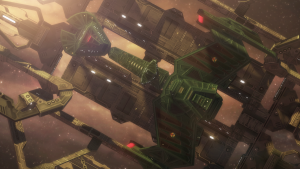Aldea
From Star Trek: Theurgy Wiki
Aldea, also known as Epsilon Mynos III, was a independent planet in the Epsilon Mynos System. A supposedly mythical world whose inhabitants constructed a planet-wide cloaking device to hide their planet from marauders. This was until 2374, when the USS Enterprise-D deactivated the cloak and the defence system for them, since the antiquated technology - while immensely powerful - had destroyed the ozone layer of the planet. When this defence system was deactivated, the sky ceased to be purple, and took on Aldea's natural gold and and red colours, which came from the reddish dust particles collected beyond the clouds of the planet - just below the atmosphere.
Since then, the Aldeans struggled to repopulate their world after generations of gradual decline. They had to repair the ozone layer, and find allies in a galaxy that was very keen to discover what Aldea had to offer, ranging from the more amiable Federation to opportunists like the Orion Syndicate and the Ferengi. After a time of great turmoil, Aldea found an ally in the Klingon Empire, and traded bits of their science and knowledge of the galaxy with the Klingons for protection. As of 2381, Aldea remained loyal to the Empire, and given the wealth of knowledge the Aldeans possessed, patrolling the Epsilon Mynos System and providing planetary defences on Aldea remained a matter of great priority for the Klingon High Council. The alliance even resulted in the construction of the Aldea Prime Shipyards, which Starfleet may have begun to build before the years of turmoil, but the Empire finished.
History
Aldea was hidden from view for millennia by its powerful planetary defence system, devised by the Progenitors and run by the Custodian - an ancient computer system that the Aldeans relied upon for all their needs. The planetary defence system included an enormous planet-wide cloaking device that hid it from marauders and other threats. In addition to the cloaking device, Aldea was defended by an immensely powerful shield that could only be penetrated by Aldean technology. Through the Custodian, the Aldeans also had access to a repulsor beam, powerful enough to push starships several hundred light years distant. The safeguards allowed the people to pursue culture and become artisans in complete safety, but as a society, they became too reliant on the Custodian, forgetting the necessary technological backgrounds of how their own technology worked.
For thousands of years, the existence of Aldea was considered to be only a rumor, similar to the cultural myths of Atlantis. However, by the mid-24th century the planet-wide cloaking device was responsible for cumulative damage to the planet's ozone layer, resulting in widespread radiation poisoning from the Aldean sun's ultraviolet rays, causing the species to become sterile. In the year 2364, to try to rectify their dire situation, the Aldeans - led by Radue, the First Appointee and leader of his planet's government - attempted to kidnap various USS Enterprise-D children in order to repopulate their planet. After the failed attempt, the Aldeans agreed to accept help from the Enterprise to relearn how to properly use their technology, never again to use their shield or cloaking device, and medical treatment reversed the radiation poisoning in the population, which would restore fertility in time.
On that day in 2374, when the Enterprise deactivated the Custodian for them, the sky ceased to be purple, and took and the natural gold and and orange colours of its atmosphere. As beautiful as the planet became, it was also bared to the threats of the Galaxy. More so, since Starfleet could do little in terms of helping the Aldeans decipher and learn how to use the Custodian. The Aldeans were split into several factions after the events. One faction, lead by Radue, favored joining the Federation. Another faction wanted to ally with the Romulans. A third with the Klingons. Yet another faction wanted Aldea to remain isolated.
Since the Custodian's defence system was deactivated, the Aldeans ceased to be a mythical people, and ended up at the mercy of all the treasure hunters in the Galaxy. The attention their planet held for external powers were a deep concern, since they did not know how to protect themselves without the Custodian. The Federation tried, but weren't prepared to commit enough forces to to protect the planet from all marauders and hostile species, much less the unsanctioned immigration of all kinds of aliens. Even though they were jeopardising the longevity and fertility of their population, they were forced to reactivate the Custodian several times so that they might defend themselves with the repulsor beam technology.
Unfortunately, there were already a lot of aliens on the planet at that time. Using the Custodian - which they were not proficient enough to use effectively to behind with - wasn´t a sustainable solution. So, when the Federation was too late to commit forces during the Maquis insurrection (2370-2373), the Aldeans made arrangements with the Klingon Empire to act as a stronger and more readily available defence force. The Federation and Starfleet might have - eventually - rallied enough forces to protect Aldea, but the Klingons proved their worth in being in the right place at the right time.
As of 2381, the Aldeans had very strong diplomatic ties to the High Council on Qo´noS. While they were still grateful to Starfleet for being able to save their people from extinction in the 60s´, the Klingons had come to protect their growth as a species. This growth, having begun merely 17 years back, and with the fate it suffered since, was fraught with different challenges. One prevalent issue was the xenophobia that the Aldeans developed, which only abated after the Klingons could protect them and allow them to appreciate the influences of other cultures in the scientific and artistic focus areas. Still, there were those Aldeans who did not appreciate sharing their lives outside their units with any alien species, Klingons included.
Since 2364, and with the planet habitable again, the Aldeans were not governed by the laws of the Federation against cloning, and used it as a means to accelerate re-population. Unfortunately, the clones - who were easily distinguished by a simple tricorder reading - were considered second-rate citizens, even though they were identical to other Aldeans. As of 2381, it remained a sensitive topic for the Aldeans.
Aldea Prime Shipyards

Class: Orbital Shipyard
Supervised by: Aldea Defence Committee & the Klingon Defence Force
Shipyard Status: 100% Operational
Location: Geostationary Orbit of Aldea; Epsilon Mynos System
Features:
27 Defence Platforms
34 Dilithium Refineries
47 Depots
59 Space Pads
279 Drydocks
1 Small spacedock
54 Antimatter Containment pods
30 Groundbase Drydocks
Image: "Till Sto-Vo-Kor" by Jetfreak-7
Aldea, disappointed in Starfleet, laid claim to the unfinished, barebone construct of the Aldea Prime Shipyards, which had been a joint venture between the Federation and Aldea until that time. Instead, the Aldeans signed a contract with the Klingon Empire, who took over the construction of the shipyards and its drydock facilities. It had a space station drydock facility and it was named for its vicinity to Aldea and its capital - Aldea Prime. The KDF (Klingon Defence Force) had full access to the facilities as of 2381, making it a natural port if they were to protect Aldea on a long-term basis.
The Aldea Prime Shipyards saw the design, testing, and construction of both Klingon and Aldean vessels, although the latter was a slow process since the Aldeans only restarted construction of interstellar crafts in the 70s'. Construction took place within a large network of manufacturing and assembly platforms, which were suspended in a vast area above Aldea and consisted of a multi-functional skeletal armatures, arranged in such a way as to easily accommodate the shape of the new craft. Many repair facilities of both the Federation and the Klingon Empire shared a common design, whose jointed support arms could cover the saucer section of a starship and allow crews to work on many parts of the vessel at the same time.
These shipyards could be accessed from orbit over Aldea or via transport from Aldea Prime, the capital of Aldea. At the shipyards and the groundbase drydocks, the repair crews were mainly Klingons, but their tasks are supervised by the Aldea Defence Committee & the Klingon Defence Force.
Aldea Prime Spacedock
There is also a small spacedock in the midst of the depots, refineries and drydocks of the shipyards, which holds accommodations for crews that can't remain on their ships during repairs. The spacedock is clearly one of paradoxical nature. In the Klingon areas, the handful of establishments range from targ breeding pits and Bat'leth forges to a sparring ring and several bars, some of which have blood wine fountains. In the Aldean areas, there are conference rooms, laboratories and observatories, and of course, a lot of art galleries and small museum area.
To the outsider, it might seem a mystery how the Aldeans and the Klingons could live in symbiosis in the small spacedock, but over the past decade, a kind of mutual understanding had come to develop. Moreover, the mutual interest in the treaty between Aldea and the Empire ensured that the two vastly different species were respectful towards each other.
Aldea Prime Groundbase Drydocks
In the outskirts of Aldea Prime - connected with the city via transport - there were also thirty drydocks for smaller ships, the dome-shaped hangars ideal for the maintenance and repairs of smallcraft and atmospheric vehicles. There were little in terms of off duty establishments at the groundbase, however, and the crews working there would beam up to the spacedock on a daily basis.


